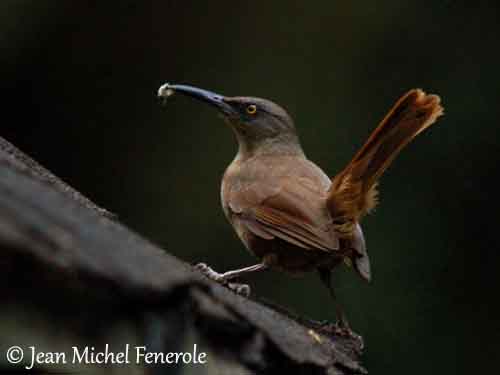
Fr: Trembleur brun
All: Braunzitterdrossel
Esp: Cocobino Pardo
Ita: Mimo codirosso
Nd: Sidderspotlijster
Sd: Brun darrhärmtrast
Photographer:
Jean Michel Fenerole
Photos d’Oiseaux du monde
Text by Nicole Bouglouan
Sources:
HANDBOOK OF THE BIRDS OF THE WORLD Vol 10 by Josep del Hoyo-Andrew Elliott-David Christie - Lynx Edicions - ISBN: 8487334725
WRENS, DIPPERS AND THRASHERS by Brewer David – illustrated by Barry Kent Mackay- Yale University Press - ISBN: 0300090595
BirdLife International (BirdLife International)
Brown Trembler
Cinclocerthia ruficauda
Passeriformes Order – Mimidae Family
INTRODUCTION:
There are two species of tremblers in the Lesser Antilles, the Brown Trembler and the Grey Trembler, both included in the genus Cinclocerthia.
The Brown Trembler is known for its habit of drooping its wings, and then, strongly trembling them. This behaviour has given the bird its name. This species is endemic to the Lesser Antilles.
DESCRIPTION OF THE BIRD:
Biometrics:
Length: 23-26 cm
Weight: 43-70 g
The adult of the nominate race has rufous-brown upperparts, with more reddish wings, tail and rump.
On the underparts, the throat is pale greyish-buff and the breast is browner. Belly, vent and undertail-coverts are buffy-brown.
On the head, crown and nape are dull blackish-brown, turning olive-brown on shoulders. Lores and ear-coverts are darker.
The slightly down-curved bill is black. The eyes are yellow. Legs and feet are brown.

Both sexes have similar plumage, but the female is slightly smaller than the male, and she has longer bill.
The juvenile has dark-grey indistinct spotting on the breast.
SUBSPECIES AND RANGE:
We can find three subspecies.
C.r. tremula is found in the N of the Lesser Antilles, on Saba, Barbuda, St Kitts, Nevis, Montserrat and Guadeloupe Islands.
This race is similar to nominate with larger bill and stronger sexual dimorphism.
C.r. ruficauda (here described) occurs on Dominica, in C Lesser Antilles.
C.r. tenebrosa occurs on St Vincent and Grenada Islands, in S Lesser Antilles.
This one has intermediate size. It is darker above, with strong greyish wash on the breast.
HABITAT:
The Brown Trembler frequents wet forest, especially with bromeliads and Araceae. It is usually less common in mossy or dry forest on mountain ridges, but it can be seen in plantations too, mainly grapefruit and cacao. But it is present throughout the islands.

CALLS AND SONGS: SOUNDS BY XENO-CANTO
The Brown Trembler’s call is a rasping “yeeeak”, and we can also hear a sharp “cht” or “chip”.
The song consists of series of loud phrases, some rather harsh, others rich and melodious, and others high and squeaky. It also utters a quiet series of complex phrases during about five seconds. During the territorial encounters, it gives a loud jumble of notes.
BEHAVIOUR IN THE WILD:
The Brown Trembler feeds from ground level up to top of large forest trees, 40 metres above the ground or higher.
It feeds on numerous arthropods, insects, spiders, scorpions, cockroaches, Coleopteran and Orthoptera. Small vertebrates such as tree-frogs and lizards are taken, and snails too. It also consumes seeds, fruits and berries.
It forages among epiphytes and probes into bromeliad clumps, cavities in tree trunks and branches, hollows in trees, where it can find invertebrates.
It also forages on the ground, hopping with cocked tail. It removes the dead leaves with the bill, and probes into the wet earth.

The “trembling” behaviour of the Brown Trembler is not well understood, but but it is still interpreted in a certain way.
It drops both wings and quivers them before to bring them back into normal position. This behaviour is usually accompanied by nervous jerking movement of the tail.
Both sexes perform regularly this display every few seconds, but more often when they are in group. This display could be a way to communicate between mates, because this species lacks contact call.
They are monogamous and territorial, and both sexes usually share the nesting duties.

The Brown Trembler is sedentary but some birds may exhibit vagrancy pattern.
Over short distances, and even much longer ones, it prefers to run rather than fly. They are mainly terrestrial birds. They feed high in trees by climbing through branches and not by flight.

REPRODUCTION OF THIS SPECIES:
The breeding season occurs in March/July.
The cup-shaped nest is made with small twigs and rootlets, and the inner cup is lined with finer rootlets, dead leaves and plant fibres. It is placed in tree cavity, or in the base of a palm frond, or in hollow stump of tree fern, usually between 3 and 10 metres above the ground.
From some reports, the nest can be domed with a side entrance that is unusual in Mimidae species. It may also use nest boxes.
The female lays 2-3 greenish-blue, unmarked eggs.
There is no information on incubation and fledging periods.
PROTECTION / THREATS / STATUS:
The Brown Trembler is common to rare in its restricted range, according to the different islands.
The species is not currently threatened.
